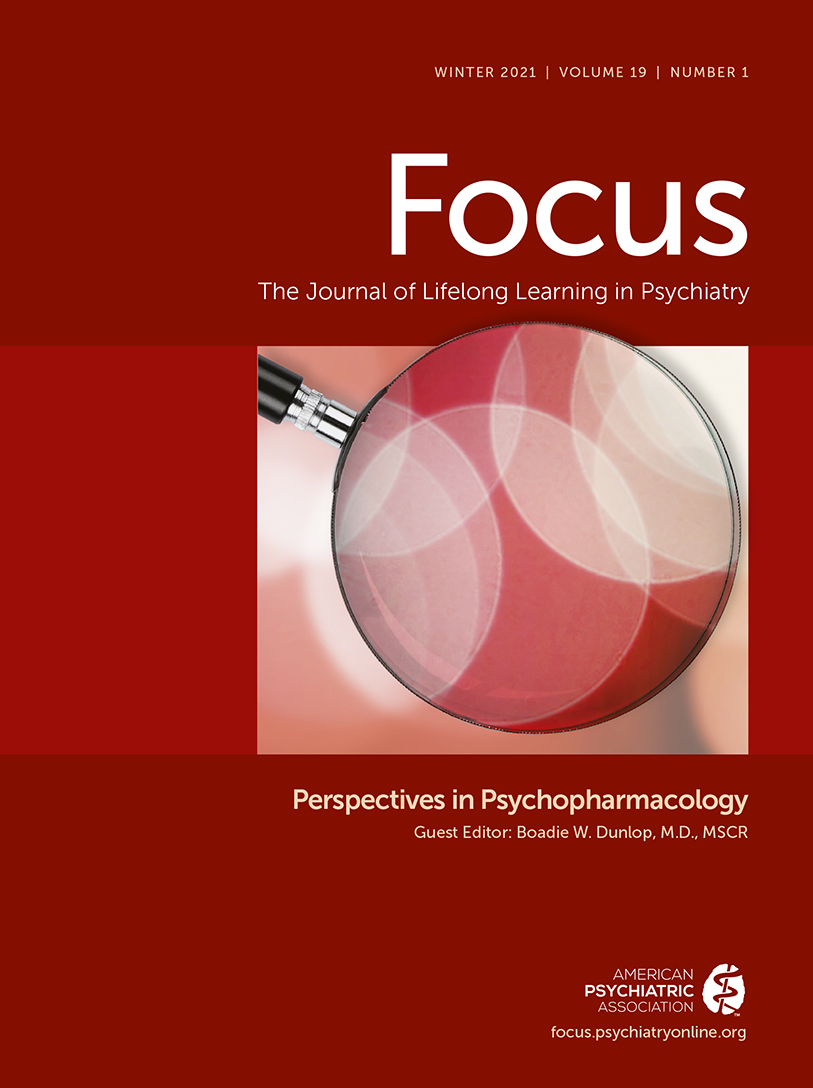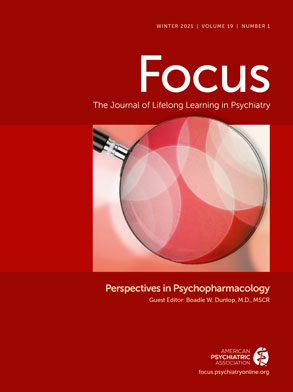Given space limitations and varying reprint permission policies, not all of the influential publications the editors considered reprinting in this issue could be included. This section contains abstracts from additional articles the editors deemed well worth reviewing.
Adjunctive Metformin for Antipsychotic-Induced Dyslipidemia: A Meta-Analysis of Randomized, Double-Blind, Placebo-Controlled Trials
Jiang WL, Cai D.B., Yin F, et al.
Transl Psychiatry 2020 Apr 23; 10(1):117
Antipsychotic-induced dyslipidemia could increase the risk of cardiovascular diseases. This is a meta-analysis of randomized double-blind placebo-controlled trials to examine the efficacy and safety of adjunctive metformin for dyslipidemia induced by antipsychotics in schizophrenia. The standardized mean differences (SMDs) and risk ratios (RRs) with their 95% confidence intervals (CIs) were calculated using the random-effects model with the RevMan 5.3 version software. The primary outcome was the change of serum lipid level. Twelve studies with 1215 schizophrenia patients (592 in metformin group and 623 in placebo group) were included and analyzed. Adjunctive metformin was significantly superior to placebo with regards to low density lipoprotein cholesterol (LDL-C) [SMD: -0.37 (95%CI:-0.69, -0.05), p=0.02; I2 = 78%], total cholesterol [SMD: -0.47 (95%CI:-0.66, -0.29), p<0.00001; I2 = 49%], triglyceride [SMD: -0.33 (95%CI:-0.45, -0.20), p<0.00001; I2 = 0%], and high density lipoprotein cholesterol [SMD: 0.29 (95%CI:0.02, 0.57), p=0.03; I2 = 69%]. The superiority of metformin in improving LDL-C level disappeared in a sensitivity analysis and 80% (8/10) of subgroup analyses. Metformin was significantly superior to placebo with regards to decrease in body weight, body mass index, glycated hemoglobin A1c, fasting insulin, and homeostasis model assessment-insulin resistance (p=0.002–0.01), but not regarding changes in waist circumference, waist-to-hip rate, leptin, fasting glucose, and blood pressure (p=0.07–0.33). The rates of discontinuation due to any reason [RR: 0.97 (95%CI: 0.66, 1.43), p=0.89; I2 = 0%] was similar between the two groups. Adjunctive metformin could be useful to improve total cholesterol and triglyceride levels, but it was not effective in improving LDL-C level in schizophrenia.
Copyright © 2020 Springer Nature
Novel Antipsychotics Specificity Profile: A Clinically Oriented Review of Lurasidone, Brexpiprazole, Cariprazine and Lumateperone
Corponi F, Fabbri C, Bitter I, et al.
Eur Neuropsychopharmacol 2019; 29(9):971–985
Second generation antipsychotics (SGAs) are effective options in the treatment of schizophrenia and mood disorders, each with characteristic efficacy and safety features. In order to optimize the balance between efficacy and side effects, it is of upmost importance to match compound specificity against patient clinical profile. As the number of SGAs increased, this review can assist physicians in the prescription of three novel SGAs already on the market, namely lurasidone, brexpiprazole, cariprazine, and lumateperone, which is in the approval phase for schizophrenia treatment at the FDA. Besides schizophrenia, EMA and/or FDA approved lurasidone for bipolar depression, brexpiprazole as augmentation in major depressive disorder and cariprazine for the acute treatment of manic or mixed episodes associated with bipolar I disorder. These new antipsychotics were developed with the aim of improving efficacy on negative and depressive symptoms and reducing metabolic and cardiovascular side effects compared with prior SGAs, while keeping the risk of extrapyramidal symptoms low. They succeeded quite well in containing these side effects, despite weight gain during acute treatment remains a possible concern for brexpiprazole, while cariprazine and lurasidone show higher risk of akathisia compared with placebo and other SGAs such as olanzapine. The available studies support the expected benefits on negative symptoms, cognitive dysfunction and depressive symptoms, while the overall effect on acute psychotic symptoms may be similar to other SGAs such as quetiapine, aripiprazole and ziprasidone. The discussed new antipsychotics represent useful therapeutic options but their efficacy and side effect profiles should be considered to personalize prescription.
Copyright © 2019 Elsevier and ECNP. All rights reserved.
Recent Developments in Drug-Induced Movement Disorders: A Mixed Picture
Factor SA, Burkhard PR, Caroff S, et al.
Lancet Neurol 2019; 18(9):880–890
A large and ever-growing number of medications can induce various movement disorders. Drug-induced movement disorders are disabling but are often under-recognized and inappropriately managed. In particular, second generation antipsychotics, like first generation agents, are associated with potentially debilitating side-effects, most notably tardive syndromes and parkinsonism, as well as potentially fatal acute syndromes. Appropriate, evidence-based management is essential as these drugs are being prescribed to a growing population vulnerable to these side-effects, including children and elderly people. Prevention of the development of drug-induced movement disorders is an important consideration when prescribing medications that can induce movement disorders. Recent developments in diagnosis, such as the use of dopamine transporter imaging for drug-induced parkinsonism, and treatment, with the approval of valbenazine and deutetrabenazine, the first drugs indicated for tardive syndromes, have improved outcomes for many patients with drug-induced movement disorders. Future research should focus on development of safer antipsychotics and specific therapies for the different tardive syndromes and the treatment of drug-induced parkinsonism.
Copyright © 2019 Elsevier Ltd.
Comparative Efficacy and Tolerability of Medications for Attention-Deficit Hyperactivity Disorder in Children, Adolescents, and Adults: A Systematic Review and Network Meta-Analysis
Cortese S, Adamo N, Del Giovane C, et al.
Lancet Psychiatry 2018; 5(9):727–738
BACKGROUND: The benefits and safety of medications for attention-deficit hyperactivity disorder (ADHD) remain controversial, and guidelines are inconsistent on which medications are preferred across different age groups. We aimed to estimate the comparative efficacy and tolerability of oral medications for ADHD in children, adolescents, and adults.
METHODS: We did a literature search for published and unpublished double-blind randomized controlled trials comparing amphetamines (including lisdexamfetamine), atomoxetine, bupropion, clonidine, guanfacine, methylphenidate, and modafinil with each other or placebo. We systematically contacted study authors and drug manufacturers for additional information. Primary outcomes were efficacy (change in severity of ADHD core symptoms based on teachers' and clinicians' ratings) and tolerability (proportion of patients who dropped out of studies because of side-effects) at timepoints closest to 12 weeks, 26 weeks, and 52 weeks. We estimated summary odds ratios (ORs) and standardized mean differences (SMDs) using pairwise and network meta-analysis with random effects. We assessed the risk of bias of individual studies with the Cochrane risk of bias tool and confidence of estimates with the Grading of Recommendations Assessment, Development, and Evaluation approach for network meta-analyses. This study is registered with PROSPERO, number CRD42014008976.
FINDINGS: 133 double-blind randomized controlled trials (81 in children and adolescents, 51 in adults, and one in both) were included. The analysis of efficacy closest to 12 weeks was based on 10 068 children and adolescents and 8131 adults; the analysis of tolerability was based on 11 018 children and adolescents and 5362 adults. The confidence of estimates varied from high or moderate (for some comparisons) to low or very low (for most indirect comparisons). For ADHD core symptoms rated by clinicians in children and adolescents closest to 12 weeks, all included drugs were superior to placebo (e.g. SMD -1·02, 95% CI -1·19 to -0·85 for amphetamines, -0·78, -0·93 to -0·62 for methylphenidate, -0·56, -0·66 to -0·45 for atomoxetine). By contrast, for available comparisons based on teachers' ratings, only methylphenidate (SMD -0·82, 95% CI -1·16 to -0·48) and modafinil (−0·76, -1·15 to -0·37) were more efficacious than placebo. In adults (clinicians' ratings), amphetamines (SMD -0·79, 95% CI -0·99 to -0·58), methylphenidate (−0·49, -0·64 to -0·35), bupropion (−0·46, -0·85 to -0·07), and atomoxetine (−0·45, -0·58 to -0·32), but not modafinil (0·16, -0·28 to 0·59), were better than placebo. With respect to tolerability, amphetamines were inferior to placebo in both children and adolescents (odds ratio [OR] 2·30, 95% CI 1·36–3·89) and adults (3·26, 1·54–6·92); guanfacine was inferior to placebo in children and adolescents only (2·64, 1·20–5·81); and atomoxetine (2·33, 1·28–4·25), methylphenidate (2·39, 1·40–4·08), and modafinil (4·01, 1·42–11·33) were less well tolerated than placebo in adults only. In head-to-head comparisons, only differences in efficacy (clinicians' ratings) were found, favoring amphetamines over modafinil, atomoxetine, and methylphenidate in both children and adolescents (SMDs -0·46 to -0·24) and adults (−0·94 to -0·29). We did not find sufficient data for the 26-week and 52-week timepoints.
INTERPRETATION: Our findings represent the most comprehensive available evidence base to inform patients, families, clinicians, guideline developers, and policymakers on the choice of ADHD medications across age groups. Taking into account both efficacy and safety, evidence from this meta-analysis supports methylphenidate in children and adolescents, and amphetamines in adults, as preferred first-choice medications for the short-term treatment of ADHD. New research should be funded urgently to assess long-term effects of these drugs.
Copyright © 2018 The Author(s). Published by Elsevier Ltd.
Risks and Benefits of Attention-Deficit/Hyperactivity Disorder Medication on Behavioral and Neuropsychiatric Outcomes: A Qualitative Review of Pharmacoepidemiology Studies Using Linked Prescription Databases
Chang Z, Ghirardi L, Quinn PD, et al.
Biol Psychiatry 2019; 86(5):335–343
Attention-deficit/hyperactivity disorder (ADHD) medication is one of the most commonly prescribed medication classes in child and adolescent psychiatry, and its use is increasing rapidly in adult psychiatry. However, major questions and concerns remain regarding the benefits and risks of ADHD medication, especially in real-world settings. We conducted a qualitative systematic review of studies that investigated the effects of ADHD medication on behavioral and neuropsychiatric outcomes using linked prescription databases from the last 10 years and identified 40 studies from Europe, North America, and Asia. Among them, 18 used within-individual designs to account for confounding by indication. These studies suggested short-term beneficial effects of ADHD medication on several behavioral or neuropsychiatric outcomes (i.e. injuries, motor vehicle accidents, education, substance use disorder), with estimates suggesting relative risk reduction of 9% to 58% for these outcomes. The within-individual studies found no evidence of increased risks for suicidality and seizures. Replication studies are needed for several other important outcomes (i.e. criminality, depression, mania, psychosis). The available evidence from pharmacoepidemiology studies on long-term effects of ADHD medication was less clear. We discuss time-varying confounding and other limitations that should be considered when interpreting results from pharmacoepidemiology studies. Furthermore, we highlight several knowledge gaps to be addressed in future research and implications for research on mechanisms of outcomes of ADHD medications.
Copyright © 2019 Society of Biological Psychiatry
KINECT 3: A Phase 3 Randomized, Double-Blind, Placebo-Controlled Trial of Valbenazine for Tardive Dyskinesia
Hauser RA, Factor SA, Marder SR, et al.
Am J Psychiatry 2017; 174(5):476–484
OBJECTIVE: Tardive dyskinesia is a persistent movement disorder induced by dopamine receptor blockers, including antipsychotics. Valbenazine (NBI-98854) is a novel, highly selective vesicular monoamine transporter 2 inhibitor that demonstrated favorable efficacy and tolerability in the treatment of tardive dyskinesia in phase 2 studies. This phase 3 study further evaluated the efficacy, safety, and tolerability of valbenazine as a treatment for tardive dyskinesia.
METHOD: This 6-week, randomized, double-blind, placebo-controlled trial included patients with schizophrenia, schizoaffective disorder, or a mood disorder who had moderate or severe tardive dyskinesia. Participants were randomly assigned in a 1:1:1 ratio to once-daily placebo, valbenazine at 40 mg/day, or valbenazine at 80 mg/day. The primary efficacy endpoint was change from baseline to week 6 in the 80 mg/day group compared with the placebo group on the Abnormal Involuntary Movement Scale (AIMS) dyskinesia score (items 1–7), as assessed by blinded central AIMS video raters. Safety assessments included adverse event monitoring, laboratory tests, ECG, and psychiatric measures.
RESULTS: The intent-to-treat population included 225 participants, of whom 205 completed the study. Approximately 65% of participants had schizophrenia or schizoaffective disorder, and 85.5% were receiving concomitant antipsychotics. Least squares mean change from baseline to week 6 in AIMS dyskinesia score was -3.2 for the 80 mg/day group, compared with -0.1 for the placebo group, a significant difference. AIMS dyskinesia score was also reduced in the 40 mg/day group (−1.9 compared with -0.1). The incidence of adverse events was consistent with previous studies.
CONCLUSIONS: Once-daily valbenazine significantly improved tardive dyskinesia in participants with underlying schizophrenia, schizoaffective disorder, or mood disorder. Valbenazine was generally well tolerated, and psychiatric status remained stable. Longer trials are necessary to understand the long-term effects of valbenazine in patients with tardive dyskinesia.

